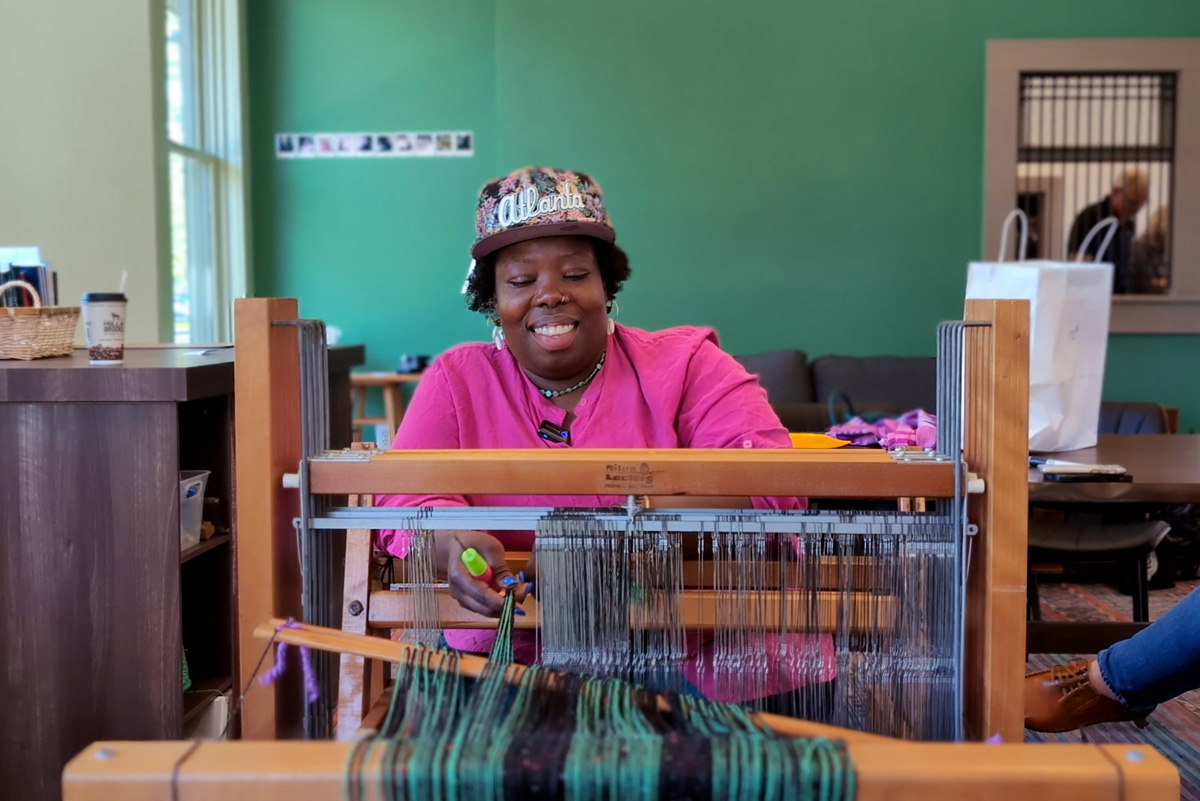
Photograph by Hannah Nemer
As the city of Hapeville is synonymous with the transportation industry—the railroad running through downtown, the major airport nearby—it’s fitting that its history museum is in the old train depot. But there’s more than just railroad memorabilia in the historic building, which was constructed in 1890 and was once a bustling waystation for train passengers and crew.
Led by director Samantha Singleton, the Hapeville Depot Museum is finding new ways to share the city’s broader history. Its latest initiative is a residency program pairing artists with public historians, who together create museum exhibitions on the lesser-known stories of this Atlanta suburb.
From its years as a fruit farming hub to the brief glory of its Atlanta Motor Speedway, Hapeville’s past—much of it informed, as in so much of the South, by the intersection of race and class—is serving as inspiration for 12 pairs of residents, each of whom brings a different perspective on the history they’ve been invited to examine.
“My work is driven by storytelling, and I’m also a craft preservationist, so I’m really loving bringing things from the past to the present purposefully,” says Camisha Butler, a textile artist who is working with public historian Nedra Deadwyler on a project about Plunkett Town, a majority-Black neighborhood south of Hapeville that was razed in the 1970s during an expansion of the Atlanta airport.
“It’s particularly interesting for me because I’m not from Hapeville, but I grew up right over the city line and . . . there was a uniform feeling that maybe Hapeville wasn’t the place for us,” Butler says. “So once I started hearing more about Plunkett Town and what happened there, I started to connect those dots.”
Butler and Deadwyler’s permanent exhibition on the history of Plunkett Town will be displayed this month as part of the residency’s first phase, unveiled during a Juneteenth celebration at the depot. Another phase-one exhibit, created by Dr. Paulette Richards, uses puppetry to examine the history of convict leasing at nearby quarries. Richards, who is serving as both artist and historian for her project, dug deep into old property records and even used geographic information system mapping to figure out where quarry owners likely exploited convict labor for profit.
“The Atlanta History Center has statues of the mules that worked the quarries on that site [where the center was built],” says Richards. “But there’s no signage that acknowledges the quarry was worked by convicts.”
Richards, a puppet maker and educator, used her research to create a puppet show exploring these themes, which she filmed for her upcoming exhibition, Of Men and Mules: Convict Leasing in Quarries of the New South.
“I find that African American puppetry is one of the most powerful modes of resistance to the objectification of Black bodies,” Richards says. “When we are manipulating the puppets, we are not objects. We are using a puppet to tell history.”
For some of the resident artists, incorporating history into their practice is novel territory. “At first I thought, Oh no, history? I was terrible in history at school!” says Emma Chammah. “But I saw where it could be powerful to incorporate community art into the history of a place.”
Chammah, a sculpture artist, is working with historian Bria Felicien on a project about Hapeville’s agricultural past: Though the city eventually became an industrial hub, Samuel Hape, inaugurated as the first mayor in 1892, originally planned to establish the town as a powerhouse fruit producer. The museum will mount their exhibit in a later phase in 2026.
Singleton hopes these pairings of artists and historians will generate new ways of engaging with Hapeville’s history. “I want this to be a space where the public can come and see the work being created,” she says. “And if they feel they are actually connected to the history, they can say, Hey, I want to talk more about this—they can be a part of that actual creation.”
Much of the history explored in these residency projects, she notes, is at risk of disappearing as those familiar with it pass away: Places like Plunkett Town aren’t well documented in official records, making their preservation by artists and historians that much more critical.
“I don’t want these stories to die with people,” says Singleton. “And I want to make sure that this museum [documents] a people’s history, not just a singular person’s history.”
This article appears in our June 2025 issue.
Advertisement




